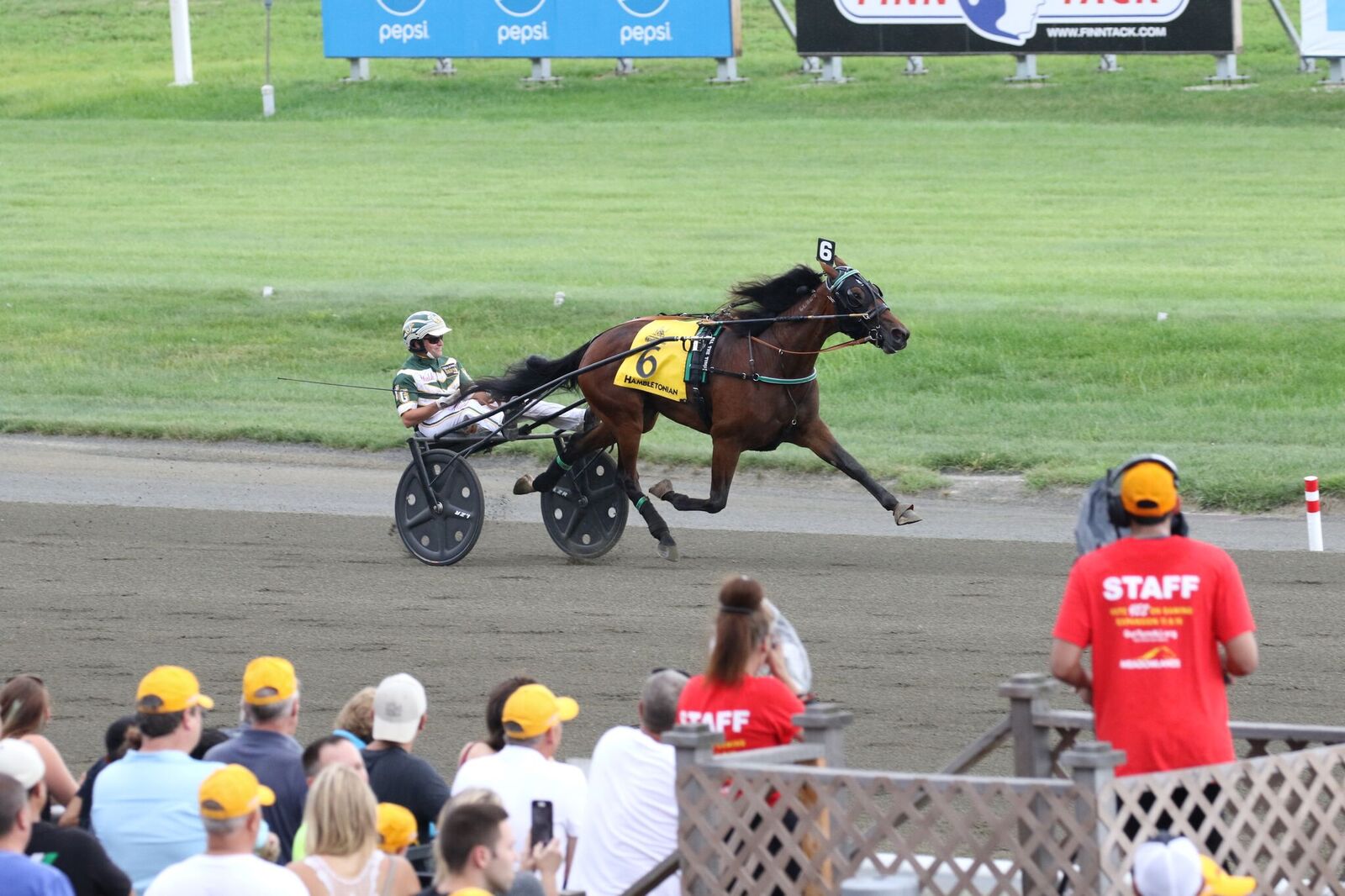Highs and Lows
Hambletonian Oaks winner All The Time battles colic and survives
by:Kimberly French
Trainer Jimmy Takter and his employees shared a sense of pride and elation over the triumph of their charge, All The Time, in the $500,000 Hambletonian Oaks last August.

Mark Hall/USTA photo
Any thought of celebrating the 3-year-old filly’s success, however, evaporated after they arrived at the barn on the morning of Aug. 7, 2016.
“When we came in and saw she was already colicking and in distress, we immediately sent her to Mid-Atlantic Veterinary Hospital,” said Takter. “We were not going to take any chances with her and they performed emergency surgery right away. We realized this was a situation where her life was in danger and even after speaking to the surgeon, we knew there was a strong possibility she might not make it.”
Owned by her breeders, Marvin Katz and Al Libfield, the daughter of Muscle Hill – Cantab It All is a full-sister and stablemate to Ariana G, the top-ranked horse in this year’s Hoof Beats Predictive Trotting Rankings. Takter also raced Cantab It All, so he said he has a special affection for the family tree of these two fillies.
As All The Time was struggling to survive in the days following her procedure, the last thing on Takter’s mind was if the filly would ever return to competition. He merely wanted her to come home safe and sound.
“They explained to us that it was 50-50 at best for her to ever race again,” he said. “But while this was happening to her, I was not thinking about that. We knew what the odds were for her to remain alive after something like this happened, so our first thoughts were only for her to make it.
“Within a few hours of the operation, the surgeon reported she was doing very well and as time went on, she continued to improve.”

Mark Hall/USTA photo
According to a study conducted by the United States Department of Agriculture (USDA), colic “refers to abdominal pain that may be caused by many different problems. In horses, most of these problems involve the gastrointestinal tract. However, diseases of other structures within or associated with the abdomen, such as kidneys, liver, uterus, and peritoneum, may also result in signs of colic. Conditions that cause colic are often placed in functional categories such as ileus, obstruction, strangulation, enteritis, and ulceration.”
The USDA estimates that colic, which can arrive in a variety of forms and can be fatal, affects 4.2 percent of all horses each year.
“The inclusive percentage of operations with one or more colic events was 16.3 percent,” stated the report. “Overall, 1.4 percent of colic events resulted in surgical intervention. The case fatality rate for all colic events was 11 percent.”
In All The Time’s situation, her condition was created by a “hole” in the lining of her intestines. The filly had never previously exhibited any behavior that would point toward her ever contracting colic.
“There is a lining that acts as a sheath around the intestines,” said Takter. “She had a tear in this lining, so her intestines needed to be contained, so the surgeon had to go in and stitch that tear together to repair the problem.”
True to the resolute nature that has yielded a lifetime record of 22-12-6-1 and $931,366 in earnings, All The Time did not experience any setbacks or complications from her condition. After spending the requisite time at Mid-Atlantic to recuperate appropriately while being closely monitored by the staff, the filly was reunited with her connections.
“She did lose a lot of weight after the surgery,” Takter said. “When we first got her back, she did not look very good because of that weight loss, but it was to be expected and she gained it back very quickly. We did change her diet to remove some of the starches and carbohydrates to aid in her digestion while she was recovering, but she has not had one problem since the surgery.

Mark Hall/USTA photo
“While her determination, which is part of her nature, definitely helped her bounce back from this as quickly as she did, Mid-Atlantic is an excellent facility and they took outstanding care of her. We remained in close contact with the surgeon throughout her stay there and when we had her home. We did not want to do one thing to jeopardize her health and everything we did with her, we checked with the surgeon for approval.”
According to a presentation by Dr. Louise Southwood of the New Bolton Center at the 2015 conference of the World Equine Veterinary Association (WEVA) in Guadalajara, Mexico, “The goal following hospital discharge is to return the gastrointestinal tract to normal function and ensure body wall healing, with the eventual objective to have the horse return to its previous use. Horses need to be monitored closely for long-term complications, particularly during the first month and then the first year following colic surgery. Postoperative colic patients need to be monitored following hospital discharge for: incisional problems; appetite; water consumption; fecal and urine output; body weight; demeanor; and signs of colic. Laminitis is relatively uncommon following colic surgery, but can be devastating.”
Just 58 days after her life appeared to be in jeopardy, the filly won a qualifier at Red Mile in 1:52.1, equaling her lifetime best.

Mark Hall/USTA photo
“What this filly accomplished is nothing short of amazing,” Takter said. “I was already impressed with how well she recovered and had no plans on ever pushing her. I qualified her myself that day and I could not believe how strong she felt. She went very easily and I could not have been more pleased with her.”
She won her Breeders Crown elimination three weeks later, then finished third in the $500,000 final. She wrapped up her 3-year-old season with a second-place finish in the $149,000 Matron Stakes at Dover Downs on Nov. 10.

Mark Hall/USTA photo
“This is a very special horse,” Takter said. “Great horses, like her, always have something that sets them apart. They can overcome any obstacles that many other horses simply cannot. This is an example of that and a very unique one. For her to win her elimination race in that short of a time after her surgery and to perform the way she did in the final was astonishing.
“We almost thought she was going to win the Breeders Crown–which only would have added to how special she already is–but again the other fillies had been racing and they were understandably tighter than her, but she still was only just short. There are very few horses that will ever do what she has.”
As All The Time prepares for her 4-year-old season, it is as if the tear in her intestinal lining that could have ended her life, is in the rearview mirror. No matter what the future holds, the mare will always inspire with her tenacity, fortitude and heart.
“Her coming back will hopefully be a great story to talk about for years to come,” Katz told Standardbred Canada.
